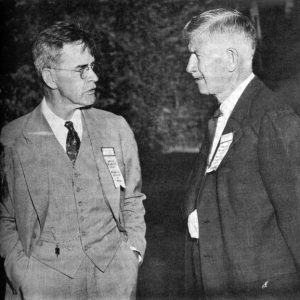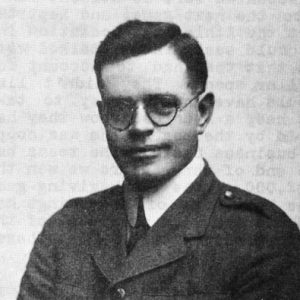calsfoundation@cals.org
Herbert Earle Buchanan (1881–1974)
Herbert Earle Buchanan was a nationally known astronomer, mathematician, teacher, and sports reformer. His research significantly advanced a mathematical understanding of the stability of the orbits of heavenly bodies, and he authored numerous college and university textbooks. Buchanan was very interested in athletics and was one of the founders of the National Collegiate Athletics Association.
Buchanan was born in Cane Hill (Washington County) on October 4, 1881, to Susan Clark Williamson and James A. Buchanan, a Civil War veteran who became a farmer, surveyor, and circuit-riding Presbyterian minister. After attending the local “subscription school,” in which the family of each attending child paid a pro-rated fee, Buchanan entered the college preparatory program at Arkansas Industrial University (later the University of Arkansas in Fayetteville) in 1898, where he earned his BA with honors in mathematics in 1902.
Buchanan enrolled in graduate study at the University of Chicago in 1902. There, he was influenced by two renowned teachers: German mathematician Heinrich Maschke, who introduced him to advanced integral calculus and plane geometry, and Forest R. Moulton, who fostered his growing enthusiasm for celestial mechanics and astronomy. In 1903, Buchanan completed his MA in mathematics.
In 1904, Buchanan married Ada C. Tilley, his longtime sweetheart and daughter of a prosperous Washington County farmer. The couple had four children.
After teaching for two years at Kentucky Military Institute in Louisville (where he both coached and played on the football team), Buchanan returned to Chicago to study astronomy. With Moulton’s help, he was able in 1908 to secure a one-year appointment to the University of Chicago’s Yerkes Observatory, which at that time had the world’s largest refracting telescope. At Yerkes, Buchanan gained valuable experience in observational astronomy and began the calculations that later became his groundbreaking doctoral dissertation, which was published by the University of Chicago Press as Periodic Oscillations of Three Finite Masses about the Langrangian Circular Solutions. This dissertation substantially advanced a mathematical understanding of the stability of the orbits of heavenly bodies.
After an unhappy start in university teaching at the University of Wisconsin, where it became clear that promotion would come but slowly, Buchanan moved in 1911 to the University of Tennessee at Knoxville, where he became a full professor after only one year. At the University of Tennessee, he was also named chairman of the Athletic Committee (a position roughly equivalent to present-day Athletic Director) and was tasked to clean up the athletic program’s finances. He quickly gained a reputation as a sports reformer in differentiating between the regulations that the big and small schools had to follow. As such, he became a founding vice president of the National Collegiate Athletic Association, with responsibility for the Southern Athletic Conference. In 1915, Buchanan joined several other leading mathematicians to form the Mathematics Association of America.
During World War I, Buchanan volunteered for national service with the Young Men’s Christian Association (YMCA). He was sent by the YMCA to investigate irregularities in its program for American servicemen in France; the organization had received reports that materiel and services that should have been provided to the troops free of charge were being sold by YMCA workers in France. After the war, he stayed to become professor of mathematics at the American Expeditionary Forces University at Beaune, France.
Work with American soldiers made Buchanan an even more enthusiastic teacher and mentor. Returning in 1920 to Tennessee, he began sending his brightest students to graduate study at the University of Chicago. Eventually, he dispatched more than twenty of his protégés to Chicago, all of whom later became heads of departments. A few became world-renowned mathematicians.
Later in 1920, Buchanan moved to head the mathematics department at Tulane University in New Orleans, where he soon published the first of seven nationally acclaimed textbooks. His texts on algebra and geometry were widely adopted in American colleges. This and Buchanan’s growing reputation as a teacher led to numerous honors and awards, including an honorary doctorate from his alma mater, UA (1928), and the designation as Tulane’s first Distinguished Professor (1937).
Buchanan retired in 1949, after fifty years of teaching and service to over 10,000 students. Though he had hoped to return to his farm near Fayetteville (Washington County), he accepted instead a plea from the Presbyterian Church to assume the interim presidency of College of the Ozarks in Clarksville (Johnson County). Over the next two years, he restored that institution’s financial and academic stability.
After he retired once again in 1951, Buchanan devoted much of his time and energy to restoring the farm and antebellum house near Fayetteville, both of which were the legacy of his wife’s family. He was also active in church and civic affairs, corresponded with numerous former students and colleagues, wrote his memoirs, and participated in experimental projects of the University of Arkansas’s College of Agriculture.
He died on January 17, 1974, from injuries sustained in a fall on icy pavement and is buried in the churchyard of the Presbyterian church in Prairie Grove.
For additional information:
Buchanan, H. E. “Memoires.” Washington County Historical Society Bulletin 59 (1974).
H. E. Buchanan Papers. Tilley House Library, near Prairie Grove, Arkansas.
H. E. Buchanan Papers. Special Collections. Howard-Tilton Memorial Library, Tulane University, New Orleans.
Rothrock, Thomas. “Dr. Buck from Cane Hill.” Arkansas Historical Quarterly 22 (Winter 1963): 332–37.
Williams, Nancy A., ed. Arkansas Biography: A Collection of Notable Lives. Fayetteville: University of Arkansas Press, 2000.
Edward A. Allen
Washington County, Arkansas
This entry, originally published in Arkansas Biography: A Collection of Notable Lives, appears in the CALS Encyclopedia of Arkansas in an altered form. Arkansas Biography is available from the University of Arkansas Press.
 Herbert Buchanan and George A. Campbell
Herbert Buchanan and George A. Campbell  Herbert Buchanan
Herbert Buchanan 




Comments
No comments on this entry yet.